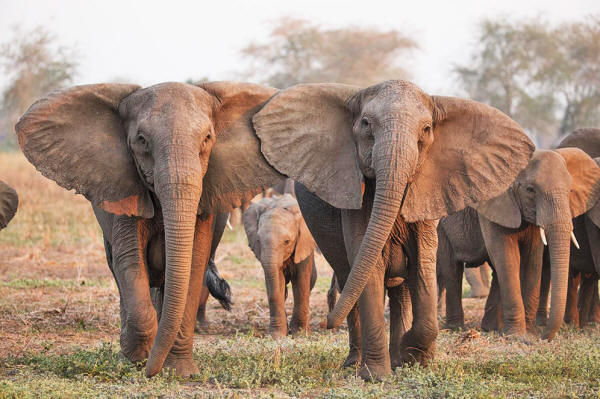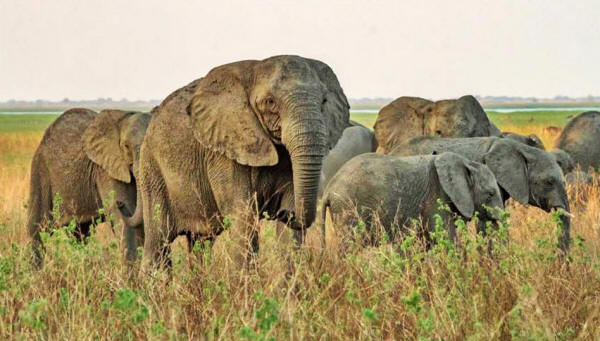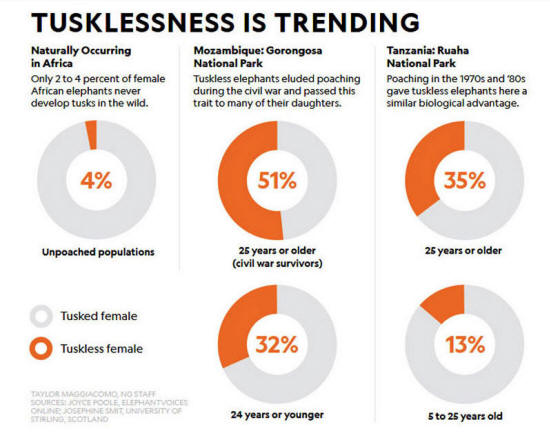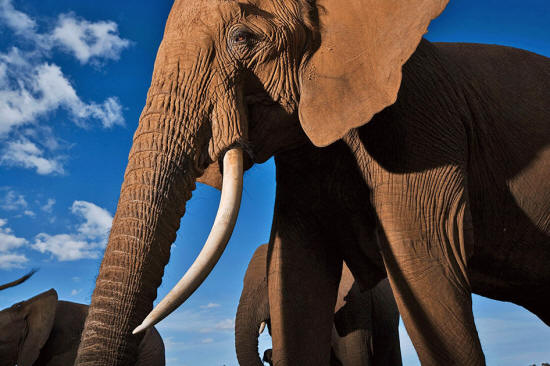|
by Dina Fine Maron
In Mozambique, researchers are racing to understand the genetics of elephants born without tusks... and the consequences of the trait.
They're the lone survivors
of a conflict that killed about 90 percent of these beleaguered
animals, slaughtered for ivory to finance weapons and for meat to
feed the fighters.
Normally, tusklessness would occur only in about 2
to 4 percent of female African elephants.
But those numbers dwindled to triple digits following the civil war.
New, as yet unpublished, research she's compiled indicates that of the 200 known adult females,
A male elephant's tusks are bigger and heavier than those of a female of the same age, says Poole, who serves as scientific director of a nonprofit called ElephantVoices.
This tuskless trend isn't limited to Mozambique, either.
Other countries with a history of substantial ivory poaching also see similar shifts among female survivors and their daughters.
In South Africa, the effect has been particularly extreme - fully 98 percent of the 174 females in Addo Elephant National Park were reportedly tuskless in the early 2000s.
This tuskless matriarch moves with her herd
across Gorongosa's
floodplain.
Josephine Smit, who studies elephant behavior as a researcher with the Southern Tanzania Elephant Program, says that among the female elephants she tracks at Ruaha National Park, an area that was heavily poached in the 1970s and 1980s, 21 percent of females older than five are tuskless.
As in Gorongosa, the numbers are highest among older females. About 35 percent of females older than 25 are tuskless, she says. And among elephants ages five to 25, 13 percent of females are tuskless.
(Smit, a doctoral candidate at the
University of Stirling, in Scotland, says the data have not yet been
published, though she presented the findings at a scientific
wildlife conference last December.)
A 2015 study (Illegal Tusk Harvest and the Decline of Tusk Size in the African Elephant) conducted by Duke University and the Kenya Wildlife Service compared the tusks of elephants captured there between 2005 and 2013 with those of elephants culled between 1966 and 1968 (that is, before significant poaching took place in the late 1970s and early 1980s) and found significant differences.
Survivors of that period of intense
poaching had much smaller tusks - they were about a fifth smaller in
males and more than a third smaller in females.
On average, male elephants born after 1995 had tusks 21 percent smaller than the males from the 1960s, and 27 percent smaller than the females from that period.
According to the study's authors,
A tuskless adult female elephant in the Gorongosa National Park woodlands has been fitted with a GPS collar so researchers can track her movements and
better understand her behavior.
Scientists say that the significant proportion
of elephants with this handicap may be altering how individuals and
their broader communities behave, and they want to find out if, for
example, these animals have larger home ranges than other elephants
because they might need to cover more ground to find recoverable
foods.
Yet they're typically used for most tasks of daily living:
The work elephants do with their tusks is vital for other animals too.
Elephants',
Tusk action also helps create habitats.
Certain lizards, for example, prefer to make their homes
in trees roughed up or knocked over by browsing elephants.
Now, Long and a team of ecology and genetic researchers are starting to study how tuskless elephants are navigating their lives.
In June, the team started tracking six adult females in Gorongosa - half with tusks, half not - from three different breeding herds.
They fitted them with GPS collars, took blood and dung samples, and plan to monitor them for a couple of years - or until the battery life in each of the collars gives out - periodically taking more fecal samples to analyze the elephants' diet.
Click
HERE to view slideshow... Their goal is to uncover more information about how these animals move, eat, and what their genomes look like. Long hopes to detail how elephants without the benefit of tusks as tools may alter their behavior to get access to nutrients.
Rob Pringle, at Princeton University, plans to look at dung samples for insights about both diet and the army of microbes and parasites that live inside each elephant's gut.
Another collaborator, Shane Campbell-Staton, an evolutionary biologist at the University of California Los Angeles, will study blood, searching for answers about how genetics influences the phenomenon of tusklessness.
Tusklessness does seem to occur disproportionately among females.
It makes sense that tuskless males wouldn't be able to compete for breeding access to female elephants, he says.
But if this trait was traditionally X-linked - passed down along the X chromosome, which helps determine sex and carries genes for various inherited traits - we would think that because males always get their X chromosome from their mothers that you'd have a really large population of males that are tuskless.
Joyce Poole corroborates this.
She says that in her entire career she's seen only three or four tuskless males - none of them in Gorongosa.
They may also be relying on other elephants' inadvertent help, she says.
Perhaps the elephants are
targeting different kinds of trees that are easier to strip, or
trees that have already had some stripping by other elephants -
giving them a prepared leverage point for tearing off bark.
Among Asian elephants, for example, a long history of hunting for ivory - as well as removing tusked elephants from the wild for labor - likely helped contribute to higher tuskless numbers there.
Exactly why the Asian and
African elephant populations have such different rates of tusklessness remains 'unexplained.'
|







